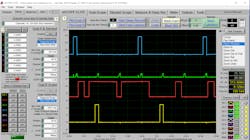Any experienced automotive technician will tell you most talented diagnosticians developed their skillset over time; they weren’t necessarily born with it. I couldn’t agree more, but my rate of learning and comprehension drastically increased as I began to implement tools used for diagnostics.
Visualizing electricity
I’ll begin by describing one of the most valuable tools at a diagnostician’s disposal, the DSO (Digital Storage Oscilloscope). This tool is highly coveted because it performs all the duties of most DVOMs but also offers a visual representation of what is occurring in the circuit. More importantly, most scopes today support this functionality for multiple channels (it’s common to see four channels but some even support eight channels!). Seeing multiple circuits operate before your eyes have many benefits. Here are a few of my favorites:
- History of electrical activity (not just what occurs at a single moment in time)
- Action/reaction view (how these multiple signals interact with one another; example: Input vs Output)
- Information stored in a buffer (no need to babysit the scope, it will capture and save the fault)
- Measuring devices
Another brilliant technology is the ability to plot measuring cursors and rulers. Many scopes will allow for two cursors to be placed vertically (to allow for measuring a single point in time, and/or the delta time between the two cursors). This becomes particularly handy when calculating events like the dwell of an ignition coil or the duration of a spark event. The view of the waveform itself may display a subtle fault that is not apparent to the naked eye. The vertical cursors can offer a more scientific approach to waveform analysis.
Like the vertical cursors, the scope may also offer two horizontal cursors to display a signal amplitude measurement, regardless of the domain you are measuring in (voltage, amperage, duty-cycle, pressure, temperature, etc.). For the same valuable reasons, the horizontal cursors can display minor variations that are not easily visible.
Rulers are another hot commodity. The rulers use the scope's software to associate elapsed time with either "percentage" or "degrees-of-rotation." A truly valuable tool, especially when it comes to engine mechanical analysis. Although this type of calculation can be easily performed using only the vertical cursors and a calculator, implementing the rulers allows the information to be displayed directly and instantaneously on the scope screen. The measuring cursors can then be used (along with the rulers) to determine delta-degrees (indicating the duration of an event, like the open time of a cylinder’s intake or exhaust valve).
Overlay software
One of the most important tools I own besides the DSO is what is known as overlay chart software. The software offers many different configurations to allow for the accomplishment of multiple tasks. However, the one feature I’m most fond of is known as a piston chart.
I frequently perform many engine-mechanical analyses, and a common issue I face is explaining my findings to my customers (or fellow technicians wanting to learn). The Piston chart offers me the ability to point out what it is I’m seeing in the capture (in other words, tell the story as it unfolds).
The piston chart is handy because it references all cylinder activity simultaneously anywhere within the entire 720-degree engine cycle. Here are just a few of the benefits:
- Comparison of piston position and direction of travel, from cylinder to cylinder
- The firing order is always displayed
- Valve overlap periods
- Top Dead-Center points/ignition events
The piston chart is plotted either superimposed on the existing waveform or above/below the existing waveform. Implementing it is as simple as opening a new window on your PC. Regarding the return on investment, the tool typically pays for itself the first time it is implemented.
Service information
Many technicians and shops in general take service information for granted. There is a lot more to it than simply referencing removal and installation instructions, labor time guides, or diagnostic flow charts. Adequate service information can yield a diagnostician a boatload of know-how without ever leaving the workbench. These are a few of the search criteria I frequently reference:
- System description/operation: We all know that each vehicle may be configured differently. This means there are multiple ways to accomplish the same intended goal and multiple options for system configuration. Having access to this piece of the diagnostic puzzle available to you is priceless. Establishing a game plan before approaching the vehicle is what it takes to stay efficient and accurate. Avoid the pitfalls that so many encounter when they don’t take the time to research this important piece of information. Approaching the vehicle without anticipation of what is supposed to occur (under certain operating conditions) is a recipe for misdiagnosis and/or expensive and embarrassing comebacks.
- Wiring diagrams: Like what was just stated above, each vehicle has the potential to be configured differently. For instance, depressing a horn pad may energize a relay to allow for a horn to sound. However, that same horn pad on a different vehicle may provide a ground path (…not for the relay) for a signal circuit to an ECU (or electronic control unit). That ECU may send that horn request to another ECU on the network. It is the job of that second ECU to energize the horn relay. After all, the horn sounds the same in either configuration. Having access to and choosing to reference that system wiring diagram, in combination with the system description and operation will allow you a few benefits, including identifying system configuration and functionality, developing anticipation of the test results before approaching the vehicle, and determining the best testing locations with the least amount of invested time
- Flowcharts: I use diagnostic flowcharts like many of us technicians do. However, I implement them differently. I choose not the follow the flowcharts, word for word. In fact, If I encounter a step in the diagnostic flow chart procedure that does not make sense to me, I do not proceed with that test. It's simply because I wouldn't know how to anticipate the results. I use flow charts for bits of data that only the manufacturer’s engineers would know (they designed the systems). I will reference the flow charts to understand the thresholds or when the ECU determines there is a fault present. Understanding what the ECU desires is part of the diagnostic process.
Other pieces of data like resistance specifications or rate of pressure leak-down (and such) are desirable to be aware of, as you will then know how to interpret the test results. Not having access to this information will leave you guessing and either have you replacing components for no reason or allowing a failing component or system to slip right past you.
The diagnostic puzzle
Being able to provide solutions to diagnostic challenges is something most of us will have to face at some point in our careers. Solving these diagnostic dilemmas is only one part of the equation. Doing so in a timely fashion is the other.
We can choose to have diagnostics as a hobby or a career. The main difference between the two options is efficiency. The examples above are just a few of the tricks I have up my sleeve.
Be creative in the way you choose to implement your tools. They will likely serve you well and give you a more solid understanding of what is truly occurring in the systems and components you are forced to address each day.
About the Author
Brandon Steckler
Technical Editor | Motor Age
Brandon began his career in Northampton County Community College in Bethlehem, Pennsylvania, where he was a student of GM’s Automotive Service Educational program. In 2001, he graduated top of his class and earned the GM Leadership award for his efforts. He later began working as a technician at a Saturn dealership in Reading, Pennsylvania, where he quickly attained Master Technician status. He later transitioned to working with Hondas, where he aggressively worked to attain another Master Technician status.
Always having a passion for a full understanding of system/component functionality, he rapidly earned a reputation for deciphering strange failures at an efficient pace and became known as an information specialist among the staff and peers at the dealership. In search of new challenges, he transitioned away from the dealership and to the independent world, where he specialized in diagnostics and driveability.
Today, he is an instructor with both Carquest Technical Institute and Worldpac Training Institute. Along with beta testing for Automotive Test Solutions, he develops curriculum/submits case studies for educational purposes. Through Steckler Automotive Technical Services, LLC., Brandon also provides telephone and live technical support, as well as private training, for technicians all across the world.
Brandon holds ASE certifications A1-A9 as well as C1 (Service Consultant). He is certified as an Advanced Level Specialist in L1 (Advanced Engine Performance), L2 (Advanced Diesel Engine Performance), L3 (Hybrid/EV Specialist), L4 (ADAS) and xEV-Level 2 (Technician electrical safety).
He contributes weekly to Facebook automotive chat groups, has authored several books and classes, and truly enjoys traveling across the globe to help other technicians attain a level of understanding that will serve them well throughout their careers.

